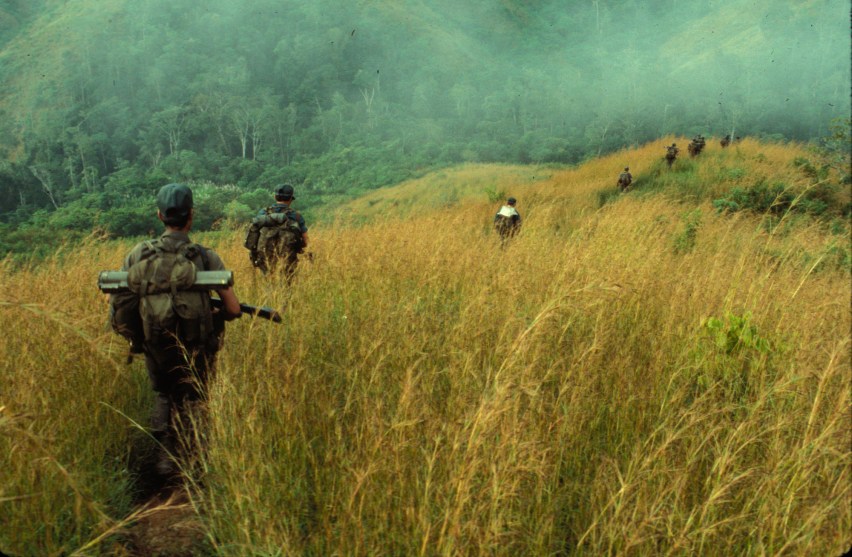
Contras on patrol in 1983 in northern Nicaragua. Bernie Sanders worried that US interventions would bring about a "Vietnam-type war" in Central America.Steven Clevenger/Corbis via Getty
This was adapted from Jonathan M. Katz’s newsletter, The Long Version. To get the backstory behind big international stories delivered to your inbox, subscribe at katz.substack.com.
On December 4, 1984, a dump truck carrying volunteer government coffee pickers was ambushed in northern Nicaragua. The attackers, rebel soldiers known as Contras, ripped through the truck with machine-gun fire and grenades, and they fired a rocket launcher into its tires. When the truck rattled to a stop, the Contras climbed aboard. They opened fire into the mangle of the living and dead, and stabbed those still moving with their bayonets—setting aside a 19-year-old woman to kidnap. Then they set the truck on fire. Roger Briones, a coffee picker who had fallen out and survived by playing dead, later testified: “I could hear the cries and laments of those who were burning alive.”
Twenty-one people were killed. Among them were a five-year-old girl and her mother, whom the volunteers had picked up hitchhiking on the road.
I thought about that earlier this month when The New York Times ran an article about Bernie Sanders’ activism in Central America during his time as mayor of Burlington, Vermont. The story focuses on Sanders’ visit to Nicaragua in July 1985, during which he made “a truncated tour of the violence-stricken country” and met with the country’s leftist president, Daniel Ortega.
The stated purpose of the profile was to illustrate Sanders’ “combative ideological persona.” “Now, as he competes for the Democratic presidential nomination, Mr. Sanders’s profound skepticism of American power appears to set him apart from other major candidates who have pledged to restore the country’s traditionally assertive global role.” The apparent smoking gun was an anti-American chant heard by a wire reporter at a rally Sanders had attended: “Here, there, everywhere, the Yankee will die!”
The authors of the Times story, Alexander Burns and Sydney Ember, are both political campaign reporters. I don’t know either of them (and they did not respond to an email asking for comment), but according to their bios, neither has much experience covering foreign affairs in general or Latin America in particular. To make the case that Sanders was an extremist in the 1980s, they offer a brief and fundamentally ahistorical summary of Nicaragua’s decade-long Contra War, then use that as a basis for a flawed foreign policy analysis.
Predictably, it resonated with other people whose sole knowledge of global politics comes from things they’ve heard in Washington. This week, New York Magazine‘s Jonathan Chait went after Sanders on the basis of the story and a testy follow-up interview, in which the senator told Ember that her focus on one rally chant suggested she did not understand the context of the war or US policy in the region. Chait declared that “she had just written a long New York Times story touching on” the events, and thus “surely knew” what she was talking about.
I’m a frequent contributor to the Times. Much as I’d like to say that writing a story for the paper automatically makes you an expert on all related matters, that isn’t how it works—especially if you’re covering a topic far from your area of expertise. That’s a problem here, because what happened in Nicaragua in the 1980s lies at the heart of Donald Trump’s United States. Not knowing the past means not understanding what’s happening today.
The Long Version
In 1979, leftist revolutionaries overthrew the US-backed dictatorship of Anastasio Somoza Debayle, the West Point–educated scion of a repressive family dynasty that had been in power since 1936. Some of the new leaders called themselves “Sandinistas,” in honor of Augusto Sandino, an early-20th-century revolutionary who’d fought against the 1912-33 US military occupation of Nicaragua and was assassinated on Somoza’s grandfather’s orders.
When the Sandinistas took full control of the government in 1981, supporters of the ex-dictator, businessmen, and some former allies tried to destroy their base of support with a new civil war. These members of the “counterrevolution”—contrarrevolución in Spanish—were known as “Contras,” for short.
Initially, the Sandinistas had tried to establish a good relationship with the United States. But Ronald Reagan had won the presidency in 1980 in part on the basis of his promise to reject Jimmy Carter’s human rights–centered approach to foreign policy, and instead be more “assertive”—to use the Times’ word—especially when it came to communism.
Contrary to some assumptions at the time (and to Chait’s error-filled column this week), Nicaragua was not communist. Neither was Ortega. But some Sandinistas were Marxist-Leninists, and the government had accepted Cuban military assistance. That was all Reagan needed to know.
Just six years after America’s defeat in Vietnam, Reagan’s advisers knew they needed to be covert in their support of the Contras—or at least covert enough not to arouse too much attention at home. Reagan directed the CIA to arm the Contras with money, weapons, and training.
One of the first Contra groups to receive this support was the Nicaraguan Democratic Force, or FDN, the group that massacred the coffee pickers. It was just one of the thousands of similar atrocities they would carry out with the financing and support of the US government.
By mid-decade, it had become abundantly clear that US policy was drowning Nicaragua in blood. When the Democratic-controlled Congress learned the CIA was putting explosive mines in Nicaraguan harbors in early 1984, it voted to outlaw military aid to the Contras.
Defying Congress, Lt. Colonel Oliver North, a member of the National Security Council, flew down to reassure the FDN in person that “President Reagan remained committed to removing the Sandinistas from power.” North then helped oversee a scheme to illegally funnel money and weapons to the rebels, in part by using profits from jacked-up weapons sales to Iran.
Since the sub-episode involved Republicans arguing with Democrats, that illegal slice of the enterprise got Americans’ attention. It became known as the Iran-Contra affair and resulted in a string of nationally televised hearings, and a few indictments and convictions.
But Americans were not nearly as interested in the more than 30,000 Nicaraguans killed in a war financed by their tax dollars. Even as the administration scrambled to cover up its crimes against Congress, the president could keep publicly boasting about his support for the Contras. In March 1985, four months after the coffee pickers were slaughtered, Reagan went to the Conservative Political Action Conference in Washington and called for millions more in military aid to Nicaragua. He said the Contras were “the moral equal of our Founding Fathers.”
Sanders’ visit to Nicaragua came that summer.
Harboring Unease
The story, the follow-up interview, and Chait’s analysis all made hay out of Sanders’ lack of “unease” at the anti-American chant. “If Mr. Sanders harbored unease about the Sandinistas,” Burns and Ember write, “he did not dwell on it.” As for the Contras’ US-sponsored war crimes, the reporters briefly summarized them in a dependent clause in the 45th paragraph of their article, saying only that “the Contras faced mounting allegations of brutal killings and other atrocities,” followed by an implied reference to Iran-Contra.
Then they both-sidesed the Nicaraguan civil war:
Contra atrocities appalled the American left, but Mr. Ortega’s forces were also implicated in grave human rights abuses, including the killing and forced relocation of civilians.
That’s misleading. Human rights observers were clear at the time on whether the Sandinistas were “just as bad” as the Contras in terms of human rights abuses. It was an especially important question because, by mid-decade, the Soviets and their allies were also belatedly contributing significant amounts of weapons, money, and training to the Sandinistas—in response to Reagan’s policy of building up arms for the Contras and right-wing regimes in Honduras, El Salvador, and Guatemala, as the historian Marc Edelman has written.
The answer was an unequivocal no. Human Rights Watch, then known as Americas Watch, found the Contras had “systematically violated the applicable laws of war throughout the conflict. They have attacked civilians indiscriminately; they have tortured and mutilated prisoners; they have murdered those placed hors de combat by their wounds; they have taken hostages; and they have committed outrages against personal dignity.”
The observers found that the Sandinista government, by contrast, had committed far fewer abuses, particularly after its first year in power. Despite attempts by the Reagan administration to convince Americans otherwise, there was “no systematic practice of forced disappearances, extrajudicial killings or torture” on the Sandinistas’ part—as there was with, for instance, US-backed right-wing regimes in nearby El Salvador. A State Department official told Americas Watch, “What we see is that the Sandinista casualties are usually legitimate battle victims,” whereas “the Contras have a tendency to kidnap young girls.”
If the Times’ political reporters harbored unease about US support for war criminals, they did not dwell on it.
And if they doubted Americas Watch’s analysis, they could have turned to a journalistic source that independently corroborated the reports of Contra atrocities, including the coffee picker massacre: the New York Times. The newspaper’s blockbuster story ran on the front page while Sanders was planning his trip. Again, this wasn’t that long ago; the expertise still exists in the newsroom.
So where did the reporters get the idea that attending a Sandinista rally in 1985 was more worthy of scrutiny and condemnation than, say, the Reaganite policies of funding death squads and terror that Sanders was protesting? Perhaps some of the answer lies with the expert source they asked to evaluate the reasonableness of Sanders’ trip: Otto J. Reich, whom Burns and Ember identify as a “former special envoy for Latin America who helped oversee Nicaragua policy for the Reagan administration.”
That’s a very weird way of describing it. Reich’s explicit job in the Reagan administration was to run a pro-Contra propaganda outfit—an effort, as The New Yorker reported in 2002, that involved leaking “false stories to the press.”
Here, There, Everywhere
I was in Nicaragua a few weeks ago, researching my upcoming book on the Marine interventions that created America’s empire. Ortega is in power again now. So I can report that, this time, the Sandinista government is the entity responsible for repressing the population. Police attacked anti-government demonstrators during my trip. They are torturing political prisoners and violating press freedom.
However, I can also tell you from being on the ground that support for the Sandinistas of the 1980s against the Reagan-backed Contras in no way necessarily translates into support for Ortega today. Lifelong Sandinistas are being thrown into prison for defying the regime. Protesters’ signature chant equates the Sandinista leader with the former US-backed dictator: “Daniel and Somoza are the same thing!” (It sounds better in Spanish.)
Again, this is obvious in Managua. It is less so if you’re a political reporter based 2,000 miles away. In their interview, Sanders tells Ember he is indeed “very concerned about the anti-democratic policies of the Ortega government”—only in the transcript published online the paper initially capitalized the “D.” It was a small mistake, but telling: This was meant to be a story about American partisan politics, not democracy.
What’s most galling is that there are people in Washington whose careers should be defined by their roles in the Contra War. One of the few Reagan officials who faced any kind of accountability for their role in the war crimes was Elliott Abrams, who in addition to being convicted of withholding evidence from Congress during Iran-Contra, funneled money to Guatemala’s murderous dictator and lied to Congress about a massacre in El Mozote, El Salvador, by a US-trained death squad. (That we know about El Mozote at all owes a lot to the reporting of Raymond Bonner for the New York Times.)
Abrams was pardoned by a lame-duck George H.W. Bush, who himself had been involved in supporting death squads as CIA director and was tangled up in Iran-Contra itself. Those pardons were underwritten by Bush’s attorney general, William Barr. Abrams is now Trump’s point man on the Venezuela crisis. Barr is now Trump’s attorney general—apparently hired to help to cover up the president’s many crimes, just as he did for Bush decades ago.
Oliver North was forced to resign as the National Rifle Association’s president last month amid an alleged extortion scheme. House Republicans called Otto Reich as an expert witness in 2018 to praise Trump’s Cuba policy. Ronald Reagan is now an airport.
Reading the Times’ coverage of the Sanders trip, it isn’t hard to understand how people who built their careers funding murder not only stay out of prison but keep reacquiring power. The burned bodies and dead children are hidden behind expert comment from fellow supporters of war criminals and gauzy talk about a “traditionally assertive global role.” Trump hires the old war criminals while posing, falsely, as an antiwar isolationist. Questions of morality are set aside. History is just a mine for gaffes.
Trump launched his campaign by promising to literally seal off the United States from the consequences of its century of Central American interventions. He has made the vilification and abuse of people from the region a cornerstone of his presidency. Political desks are going to spend the next 17 months sorting through the views of the people who want to challenge him—people who, like Sanders, had their views even more directly shaped by the region’s recent, bloody history. How can we rely on that coverage if the journalists don’t even know what that history is?
Jonathan M. Katz is a freelance journalist, author, and ASU Future of War Fellow at New America. You can sign up for his newsletter, The Long Version, at katz.substack.com.








